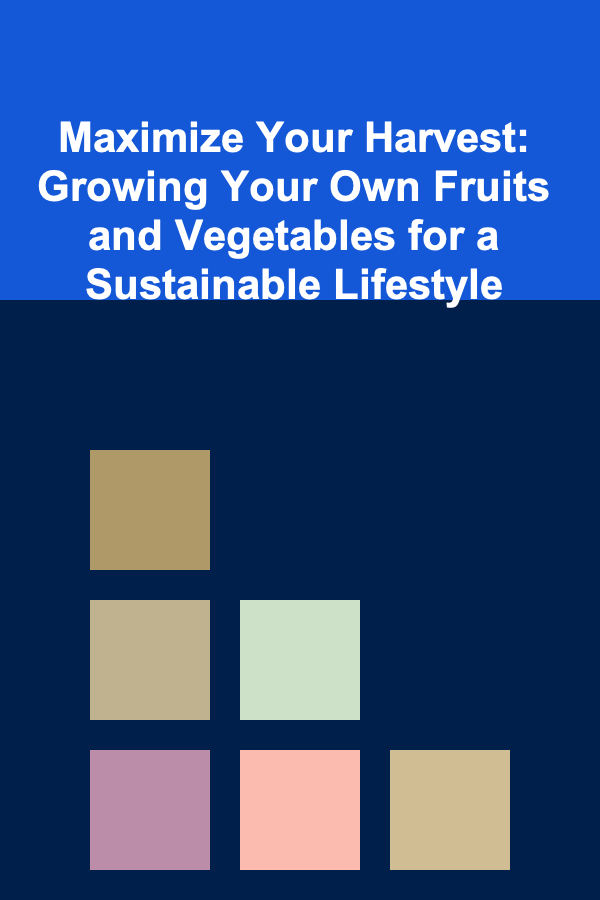
Maximize Your Harvest: Growing Your Own Fruits and Vegetables for a Sustainable Lifestyle
ebook include PDF & Audio bundle (Micro Guide)
$12.99$11.99
Limited Time Offer! Order within the next:

As the world faces growing concerns about climate change, food security, and sustainability, many people are turning to a more self-sufficient way of life. Growing your own fruits and vegetables is an empowering practice that not only ensures access to fresh, nutritious produce but also reduces your environmental footprint. Whether you have a sprawling garden, a small backyard, or even just a balcony, maximizing your harvest is within reach. In this actionable guide, we'll explore how to grow your own fruits and vegetables efficiently, ensuring a bountiful harvest while embracing a sustainable lifestyle.
Plan Your Garden with Purpose
Why Planning Matters
Effective gardening begins with thoughtful planning. By mapping out your garden and selecting the right crops for your space, climate, and personal preferences, you can maximize your harvest while minimizing waste. The right plan will also ensure that your garden is productive throughout the growing season, from early spring to late fall.
Steps to Take:
- Assess Available Space: Whether you have a small balcony, a raised bed, or an entire garden plot, the amount of space you have will guide your plant selection. Vertical gardening, container gardening, and raised beds are great options for limited space.
- Consider the Climate: Some fruits and vegetables thrive in warmer climates, while others prefer cooler temperatures. Research which crops are best suited for your region, taking into account local weather patterns, frost dates, and growing zones.
- Plant for Your Needs: Choose vegetables and fruits that your household will use regularly. This reduces waste and ensures you're growing what you will actually harvest and consume. If you're a beginner, start with hardy, easy-to-grow varieties like tomatoes, lettuce, peppers, and herbs.
- Crop Rotation and Companion Planting: Plan for crop rotation to prevent soil depletion and reduce the risk of pests and diseases. Companion planting---growing certain plants together to enhance growth and deter pests---can boost your garden's productivity.
Actionable Tip:
- Start with fast-growing, high-yield crops such as salad greens, spinach, and radishes, which will provide quick returns and build your confidence as you expand your garden.
Start with Quality Soil and Fertilization
The Foundation of a Healthy Garden
Soil health is the foundation of any successful garden. Plants derive essential nutrients from the soil, and healthy soil supports strong root systems and overall plant vitality. Fertilization is also critical for providing nutrients that may be missing from the soil, especially if you're growing in containers or raised beds.
Steps to Take:
- Test Your Soil: Before you begin planting, conduct a soil test to determine its pH and nutrient levels. This will help you understand any soil deficiencies and how to amend them.
- Improve Soil Structure: Add organic matter like compost, manure, or mulch to improve soil structure, water retention, and nutrient availability. For clay-heavy soil, incorporate sand or perlite to enhance drainage. For sandy soil, add organic matter to increase water retention.
- Organic Fertilizers: Use organic fertilizers like fish emulsion, seaweed extracts, and compost tea to provide your plants with essential nutrients. These fertilizers enrich the soil while supporting long-term health.
- Mulching: Mulch not only conserves moisture and suppresses weeds but also breaks down over time, adding valuable organic matter to the soil.
Actionable Tip:
- Apply compost or organic fertilizer every few weeks, especially during the growing season, to keep your plants well-fed. Avoid over-fertilizing, as this can lead to nutrient imbalances and harm the plants.
Water Efficiently
Why Watering Matters
Watering is one of the most critical factors for growing healthy fruits and vegetables. However, many gardeners tend to either overwater or underwater, both of which can harm plants. Efficient watering techniques not only ensure that your plants get the moisture they need but also conserve water, making your garden more sustainable.
Steps to Take:
- Water Deeply, Not Frequently: Instead of shallow watering, focus on watering deeply. Deep watering encourages roots to grow deeper into the soil, which helps plants withstand heat and drought conditions.
- Water at the Right Time: Water your garden early in the morning or late in the afternoon to minimize water loss due to evaporation. Avoid watering during the hottest part of the day, as the water will evaporate before it reaches the roots.
- Use Drip Irrigation or Soaker Hoses: A drip irrigation system or soaker hoses deliver water directly to the base of plants, reducing water waste and ensuring that moisture is directed to the root zone where it's most needed.
- Rainwater Harvesting: Consider setting up a rainwater harvesting system to collect and use rainwater for your garden. This not only reduces your water bill but also provides plants with natural, chemical-free water.
Actionable Tip:
- Install a rain gauge or moisture meter to monitor soil moisture and adjust your watering schedule accordingly. This helps you avoid overwatering and ensures optimal conditions for plant growth.
Maximize Space with Vertical Gardening
Why Vertical Gardening Works
In small gardens or urban environments, space can be limited. Vertical gardening takes advantage of unused vertical space, allowing you to grow more plants in a smaller footprint. This method works especially well for climbing plants such as tomatoes, beans, peas, cucumbers, and certain fruits like strawberries.
Steps to Take:
- Use Trellises, Cages, and Poles: Set up vertical structures like trellises, tomato cages, or poles to support climbing plants. Ensure these structures are sturdy enough to support the weight of the plants as they grow.
- Create a Vertical Garden System: Use tiered planters, hanging baskets, or vertical garden walls to grow herbs, strawberries, or flowers. This maximizes your planting area and adds aesthetic appeal to your space.
- Grow Vertical-Friendly Crops: Choose crops that are naturally inclined to grow vertically. Beans, peas, cucumbers, and tomatoes are great options. You can also grow herbs like basil and oregano in hanging pots.
Actionable Tip:
- For vining crops, choose varieties that are bred for vertical growth, such as bush beans or compact cucumber varieties, to optimize space even further.
Pest and Disease Management Without Chemicals
Protecting Your Harvest
Pests and diseases are common challenges for home gardeners. While pesticides are often the go-to solution, they can harm beneficial insects, pollute the environment, and contaminate the produce you grow. Sustainable gardening encourages natural pest control methods that keep your garden healthy without harming the ecosystem.
Steps to Take:
- Encourage Beneficial Insects: Plant flowers like marigolds, daisies, and sunflowers that attract beneficial insects such as ladybugs, bees, and predatory wasps. These insects help control pest populations naturally.
- Use Organic Pesticides: If pests become a problem, consider using organic pesticides like neem oil, insecticidal soap, or diatomaceous earth. These options are safer for the environment and beneficial insects.
- Crop Rotation: Rotate your crops every season to prevent pests from becoming established in the soil. This helps break the pest lifecycle and reduces the risk of soil-borne diseases.
- Companion Planting: Some plants can repel pests naturally. For example, planting basil with tomatoes can deter aphids, while garlic can help repel pests like aphids and beetles.
Actionable Tip:
- Regularly inspect your plants for pests and diseases. Early detection allows you to address issues before they escalate and protect your harvest from damage.
Harvesting and Preserving Your Bounty
Getting the Most Out of Your Plants
Once your fruits and vegetables are ready for harvest, knowing the right time to pick them ensures the best flavor and nutritional content. Additionally, preserving your harvest through canning, freezing, or drying allows you to enjoy homegrown produce long after the growing season ends.
Steps to Take:
- Know When to Harvest: Each type of plant has a specific harvesting time. For example, tomatoes should be picked when they are fully ripe, while leafy greens like spinach can be harvested as soon as they are large enough.
- Preserve Your Produce: Canning, freezing, or drying fruits and vegetables extends their shelf life. Invest in good-quality canning jars, freezing containers, or dehydrators to preserve your bounty for later use.
- Compost Waste: If you have leftover plant material that can't be preserved, compost it to return valuable nutrients to the soil. Composting reduces waste and supports the health of your garden.
Actionable Tip:
- Harvest in the early morning for the best flavor, as the plants will be cooler and the moisture content will be higher. This ensures that your produce is fresh and nutritious.
Conclusion
Growing your own fruits and vegetables is a rewarding practice that empowers you to live more sustainably, save money, and enjoy fresh, healthy produce. By carefully planning your garden, nurturing your soil, watering efficiently, and using sustainable pest control methods, you can maximize your harvest and create a thriving garden that supports your sustainable lifestyle. Embrace the journey of growing your own food---one plant at a time---and contribute to a healthier planet.

How to Build a Checklist for Conducting Effective One-on-One Meetings
Read More
How to Create a Cozy, Organized Home Library
Read More
How to Mix Ambient and Accent Lighting for the Perfect Living Room
Read More
How to Run an Online Training or Consulting Business: An Actionable Guide
Read More
How to Use Credit Cards Responsibly and Build Your Credit Score
Read More
How to Research Korean Mythology and Folk Tales: A Comprehensive Guide
Read MoreOther Products

How to Build a Checklist for Conducting Effective One-on-One Meetings
Read More
How to Create a Cozy, Organized Home Library
Read More
How to Mix Ambient and Accent Lighting for the Perfect Living Room
Read More
How to Run an Online Training or Consulting Business: An Actionable Guide
Read More
How to Use Credit Cards Responsibly and Build Your Credit Score
Read More